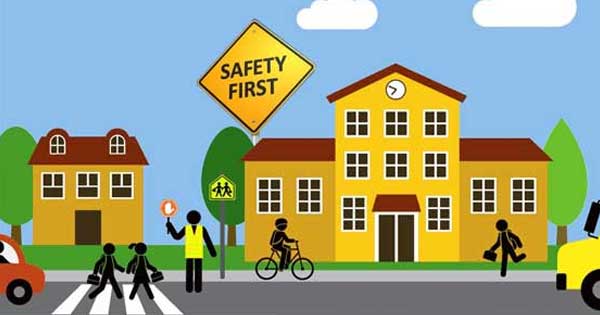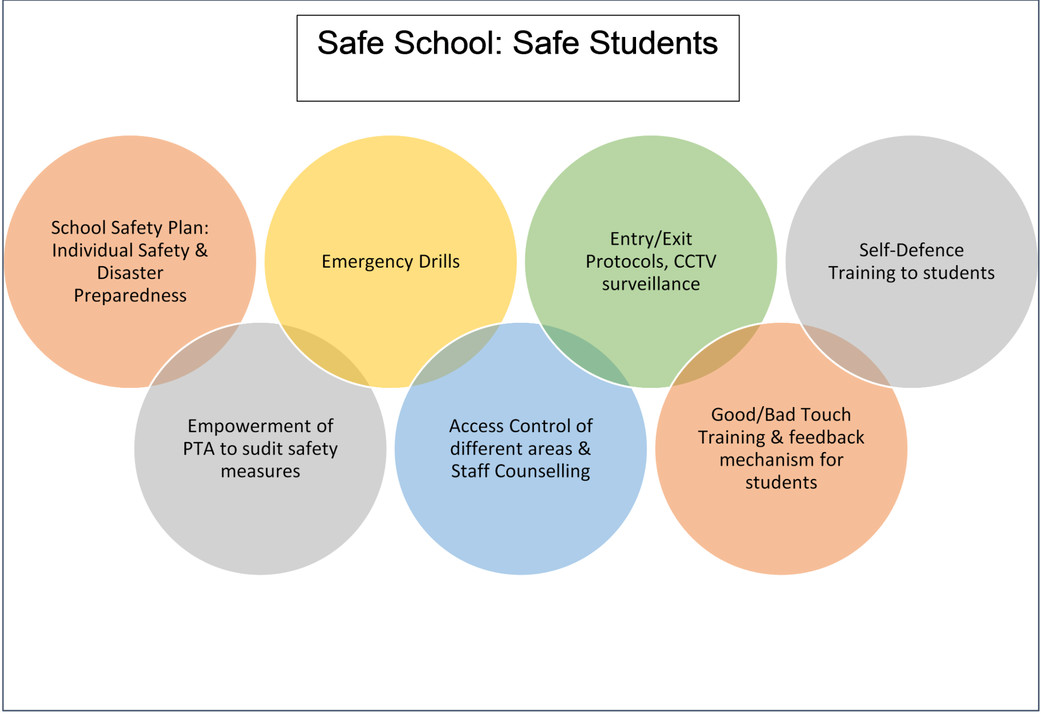The safety and well-being of students in schools are paramount for parents, educators, and policymakers worldwide. Establishing a secure and supportive learning environment is crucial for the overall development of children. School safety measures go beyond protocols and procedures; they embody a fundamental commitment to fostering an atmosphere where students can learn, grow, and flourish without fear or distraction. In this blog, we will cover what the safety measures at school are.
Safeguarding India’s Future
In India, where millions of students attend educational institutions daily, ensuring their safety is a top priority for parents, educators, and policymakers. To achieve this, schools implement various safety measures that offer peace of mind to both students and their parents.

Read More Blog: Girl’s Boarding Schools in Rajasthan with the Best Facilities in a Safe and Secure Environment
Importance Of Safety Rules In School
Here are some of the reasons why school safety measures are important and how they contribute to the overall success and happiness of students.
-
Physical and Emotional Well-being:
A safe school environment protects students from physical harm, accidents, and violence, creating a sanctuary where they can concentrate on their studies, social interactions, and extracurricular activities without constantly worrying about their safety. Furthermore, emotional security allows students to express themselves freely, boosting their self-esteem and confidence.
-
Optimal Learning Environment:
When students feel safe, they are more likely to engage actively in the learning process. A sense of security allows them to concentrate on their studies, participate in class discussions, and explore their creativity. In such an environment, teachers can effectively impart knowledge and nurture a love for learning, resulting in improved academic performance.
-
Building Trust and Confidence:
Implementing robust safety measures in schools fosters trust among parents, reassuring them that their children are in a protected environment. This trust is crucial for parental involvement in their child’s education and the broader school community. When parents are confident in their children’s safety at school, they are more likely to support school initiatives, collaborate with educators, and actively participate in school activities.
-
Preventing Bullying and Harassment:
School safety measures are vital in preventing and addressing issues such as bullying, harassment, and discrimination. Awareness programs, strict policies, and preventive measures cultivate a culture of respect and tolerance, clearly signaling that such behaviors are unacceptable. By promoting a positive and inclusive atmosphere, schools empower students to stand up against bullying and support one another.
-
Emergency Preparedness:
School safety measures include comprehensive emergency preparedness plans, covering natural disasters, fire drills, and lockdown procedures. Being well-prepared for emergencies ensures that students and staff know how to respond effectively, minimizing potential harm. Quick and organized responses during crises are crucial for safeguarding lives and reducing damage.
-
Promoting Mental Health:
Safety measures go beyond physical protection to include mental health support. Schools that prioritize mental health resources, counseling services, and emotional well-being programs create a nurturing environment where students can seek help when needed. Addressing mental health concerns promptly is essential for students’ overall development and happiness.
-
Fostering a Positive School Culture:
Schools with comprehensive safety measures foster a positive and respectful school culture. When students, teachers, and staff feel safe and supported, they are more likely to collaborate, communicate openly, and cultivate a sense of belonging. A positive school culture enhances social interactions, reduces conflicts, and creates an environment conducive to learning and personal growth.

Key Safety Measures At School
1. Safety Measures At School
Implementing comprehensive safety protocols, including secure entry points, surveillance systems, and regular safety drills, to ensure a protected environment for students and staff.
2. Emergency Preparedness
Developing and practicing detailed emergency response plans for various scenarios such as natural disasters, lockdowns, and evacuations, ensuring readiness for any crisis.
3. Secure Learning Environment
Maintaining a safe and inclusive atmosphere by enforcing visitor protocols, having security personnel on campus, and fostering a culture of respect and vigilance.
4. Emergency/First Aid Solutions
Equipping schools with first aid kits, AEDs, and trained staff ready to provide immediate medical assistance during emergencies, reducing risks and improving outcomes.
5. Emotional Safety
Providing support systems like counseling services, anti-bullying programs, and mental health resources to nurture students’ emotional well-being and create a supportive school environment.
6. Parental Involvement
Encouraging parents to participate in safety planning, volunteer programs, and regular communication with the school to enhance overall safety measures and community trust.
7. Cybersecurity Awareness
Educating students and staff on safe online practices, implementing robust cybersecurity measures to protect personal data, and monitoring for cyber threats.
8. Transportation Safety
Ensuring the safety of students during transportation by maintaining buses, training drivers in safety protocols, and establishing clear pick-up and drop-off procedures.
9. Student Safety Committee
Forming committees comprising students, teachers, and administrators to discuss and address safety issues, promoting a collaborative approach to enhancing school security.
10. Student Safety Programs
Implementing programs that educate students on personal safety, conflict resolution, and emergency response, empowering them to protect themselves and others.
11. Zero-Tolerance Policy
Enforcing strict policies against violence, bullying, and substance abuse to maintain a safe and respectful school environment for all students.
12. Law enforcement
Collaborating with local law enforcement agencies to have a visible presence on campus, provide safety training, and ensure quick response to incidents.
13. Preventing bullying and harassment
Establishing clear anti-bullying policies, providing support for victims, and implementing educational programs to foster a culture of respect and inclusion.
14. Health and Hygiene Protocols
Promoting good hygiene practices, maintaining clean facilities, and having protocols in place for managing illnesses to ensure the health and safety of students and staff.
15. Fire safety
Conducting regular fire drills, maintaining functional fire extinguishers and alarms, and educating students and staff on evacuation procedures to prepare for fire emergencies.
Final Words
Ensuring the safety and well-being of students is paramount for any leading educational institution. By implementing comprehensive safety measures such as detailed emergency preparedness plans, secure learning environments, first aid solutions, and robust cybersecurity practices, schools can create a protected space where students thrive. Parental involvement, effective transportation safety protocols, and student safety programs further enhance this secure environment. Additionally, strict zero-tolerance policies against bullying and substance abuse, collaboration with law enforcement, and maintaining high health and hygiene standards are crucial. These measures, consistently and effectively applied, ensure a safe, nurturing, and conducive learning environment, allowing students to focus confidently on their education.
At Heritage Girls School in Udaipur, we prioritize these safety measures to provide the best and safest educational experience for your child. Visit us to learn more about our commitment to student safety and well-being.
Frequently Asked Questions (FAQ)
- What safety protocols are used in school to ensure the utmost security of students?
Answer: To ensure student security, schools use controlled access points, surveillance systems, regular safety drills, and trained staff in emergency response, first aid, and crisis management.
- How do schools prepare itself for emergency situation?
Answer: Schools prepare for emergencies by conducting regular safety drills, developing detailed emergency plans, and training staff in crisis management and first aid.
- What safety measure is taken by schools to ensure transportation safety of children?
Answer: Schools ensure transportation safety by maintaining buses, training drivers, establishing clear pick-up/drop-off procedures, and using GPS tracking systems.
- What is the role of Student Safety Committee at schools?
Answer: The Student Safety Committee addresses safety issues, promotes awareness, and collaborates with staff and students to enhance the school’s safety environment.
- What is zero tolerance policy?
Answer: A zero-tolerance policy strictly prohibits behaviors such as violence, bullying, and substance abuse, enforcing severe consequences for violations to maintain school safety.
- What is the role of a teacher in school?
Answer: Teachers educate students, foster a supportive learning environment, ensure safety, and act as role models and guides for their academic and personal development.
- What are 10 safety rules on a playground?
Answer:
- Use equipment properly.
- No pushing.
- Wait your turn.
- Stay within boundaries.
- No running near equipment.
- Wear appropriate footwear.
- Report damage.
- Avoid wet surfaces.
- Be mindful of others.
- Supervise younger children.
- What are the safety rules at science labs?
Answer:
- Wear protective gear.
- Follow instructions.
- No food/drinks.
- Know emergency procedures.
- Label chemicals.
- Handle equipment properly.
- Clean up spills immediately.
- Dispose of waste correctly.
- Report accidents.
- Maintain a tidy workspace.
- What are the safety rules in the Classroom?
Answer:
- Follow teacher’s instructions.
- Keep aisles clear.
- Use materials properly.
- No running.
- Report hazards.
- Maintain cleanliness.
- Be respectful.
- Know emergency exits.
- Avoid distractions.
- Be aware of allergies.
- What are the safety rules for students on a school bus?
Answer:
- Stay seated.
- Wear seatbelt if available.
- No shouting.
- Keep aisles clear.
- Follow driver’s instructions.
- No throwing objects.
- Wait for the bus to stop before standing.
- Use handrails.
- Keep head/hands inside.
- Report issues to the driver.
- What are the consequences of breaking safety rules at school?
Answer: Consequences for breaking safety rules can include warnings, detention, suspension, or expulsion, depending on the severity of the infraction and school policies.
- What can parents do to help their children stay safe at school?
Answer: Parents can educate their children on safety, maintain open communication with the school, participate in school activities, and ensure their child follows safety protocols.
- How can schools promote a culture of safety?
Answer: Schools can promote a safety culture by regularly training staff and students, involving parents, implementing clear safety policies, and encouraging reporting of unsafe behaviors.
- What should teachers do to create a safe school environment?
Answer: Teachers should enforce rules consistently, foster an inclusive atmosphere, monitor student behavior, and be vigilant in identifying and addressing safety concerns.
- What are some additional tips for kids to stay safe at school?
Answer: Kids should stay aware of their surroundings, report suspicious activities, follow school rules, use buddy systems, and communicate with trusted adults about any concerns.



